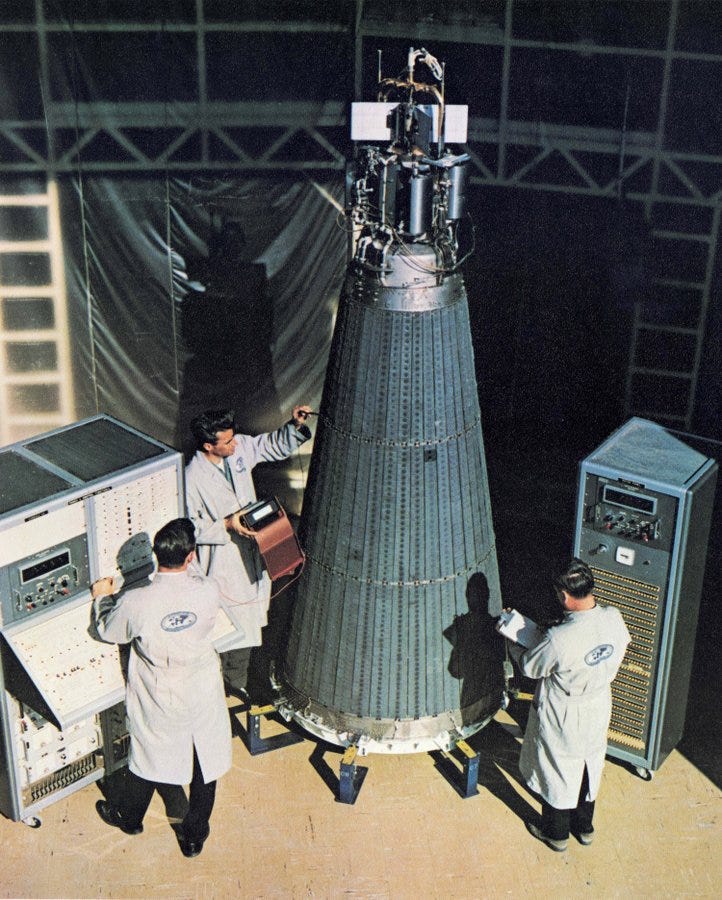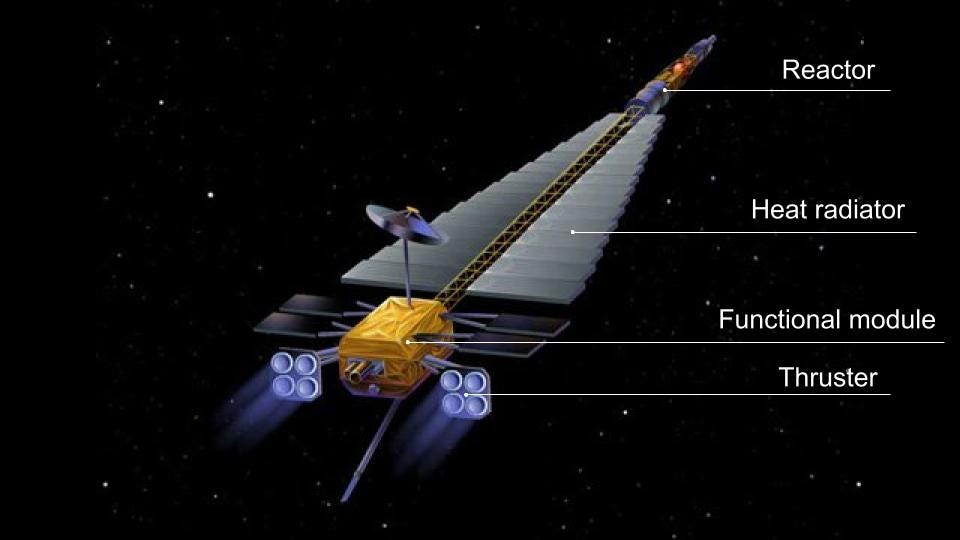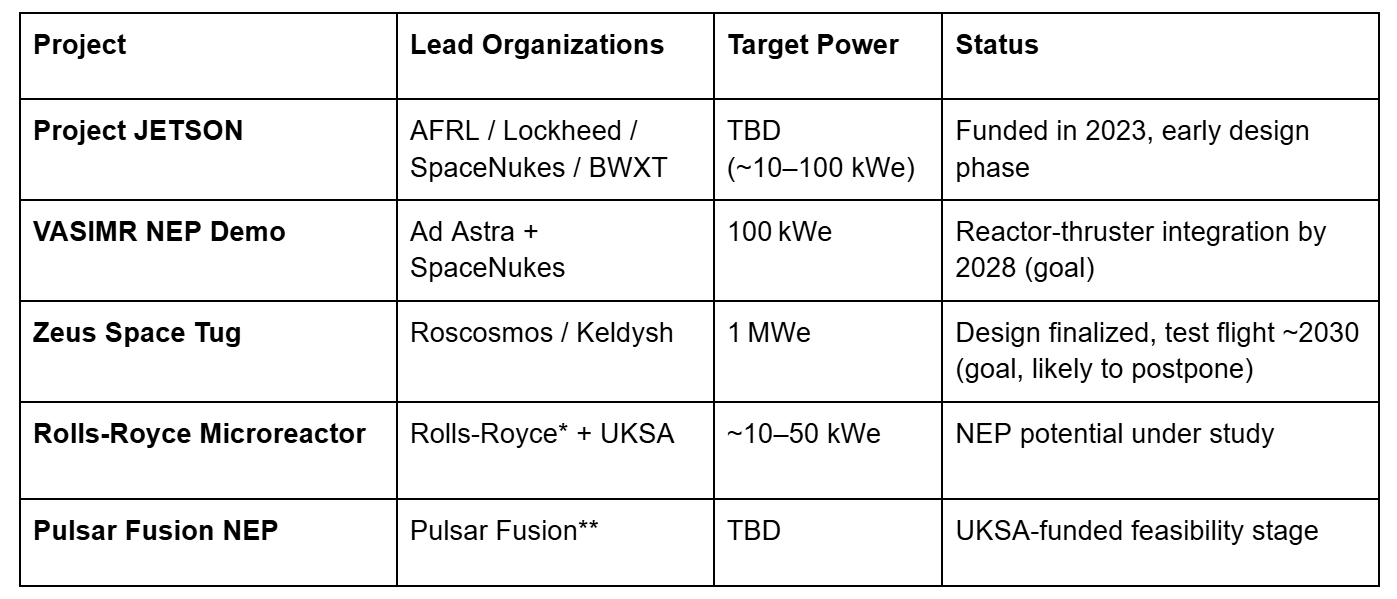Nuclear Electric Propulsion: Promise and Persistent Bottlenecks
Nuclear Electric Propulsion (NEP) offers unmatched fuel efficiency and mission flexibility. But its adoption is slow, and the question remains: Is NEP truly gaining ground, or just orbiting in theory?
Issue: 132. Subscribers: 62,765.
As momentum for deep space exploration builds, Nuclear Electric Propulsion (NEP) has resurfaced as a promising solution to key challenges in long-range spaceflight. Unlike chemical or even nuclear thermal propulsion (NTP), NEP offers unmatched fuel efficiency and mission flexibility. But its adoption has been slow, and the question remains: Is NEP truly gaining ground, or just orbiting in theory?
NEP systems use a fission reactor to generate electricity, which powers high-efficiency electric thrusters. Theoretically, this allows spacecraft to gradually accelerate over long periods, achieving high delta-V with minimal propellant consumption. NASA and the U.S. military have studied NEP since the 1960s, with projects like SNAP-10A (1965), SP-100 (1980s), and Kilopower (2010s). The Soviets flew dozens of compact reactors (BES-5 and Topaz) on orbital satellites in the 1970s-80s. Those early systems were used mainly for powering spacecraft systems, not propulsion, but they proved nuclear electric power’s viability in space. Today, programs like AFRL’s Project JETSON and commercial efforts by Ad Astra Rocket Company and SpaceNukes are reviving the concept. Meanwhile, Russia’s TEM/Zeus tug and China’s long-term plans signal continued global interest.

But it’s too early to declare a revival. The U.S. NEP roadmap remains largely exploratory, and budget pressures are growing. In 2025, the Artemis program saw proposed cuts under renewed political scrutiny. No NEP system has flown since SNAP-10A, and none are yet scheduled for deployment this decade. In contrast to the clear acceleration of launch innovation and lunar lander development, NEP’s momentum is marginal, constrained by high costs, limited near-term use cases, and unresolved engineering bottlenecks.
That said, the private space economy is evolving rapidly. If in-space logistics, resource harvesting, or high-power satellites become dominant, NEP may shift from “too early” to “inevitable.” The potential is there, but key challenges must be solved first.
This article is a short version of a paid report that Space Ambition can customise for your needs. If you’d like to get a full version, please contact our co-founder Dr. Ivan Khrapach via email ivan@spaceambition.org.
What Is NEP and How Does It Work?
NEP systems consist of three core elements:
A nuclear fission reactor that produces thermal energy.
A power conversion system that turns thermal energy into electricity.
An electric propulsion system, such as an ion or Hall-effect thruster.
This is distinct from Nuclear Thermal Propulsion (NTP), where the reactor heats a propellant (like hydrogen) and expels it for direct thrust. NTP offers high thrust and ~900 s specific impulse – suitable for fast crewed Mars transfers. NEP, in contrast, offers very high efficiency (specific impulse, Isp~3,000s, up to 12,000 s reported) but extremely low thrust, making it ideal for long-duration cargo or science missions.
How Thermal Energy Becomes Electricity in NEP
NEP depends on converting the intense heat from nuclear fission into usable electric power. There are several methods:
Thermoelectric conversion: Uses semiconductor materials (like bismuth telluride) that generate a voltage when exposed to a temperature gradient. Simple and solid-state, but low efficiency (~3–7%).
Thermionic conversion: Electrons “boil off” a hot emitter surface and are collected at a cooler electrode. This method was used in Russia’s Topaz reactors. Efficiency is slightly higher (~10%), but materials degrade over time.
Dynamic thermal cycles: Brayton or Stirling engines use gas to convert heat into mechanical work, then into electricity. These offer much higher efficiency (up to ~30%) but involve moving parts and complex thermal management.
Conversion of thermal energy into electrical energy is, of course, a factor that reduces the overall efficiency. But the high efficiency of electric engines compensates for this, and in terms of conversion of nuclear fuel into kinetic energy, NEP and NTP are more or less on par. In terms of the efficiency of using the propellant mass, NEP is much more efficient.
Most modern NEP concepts, like NASA’s Kilopower or Russia’s Zeus tug, target Brayton cycles or advanced Stirling generators for higher power density and conversion efficiency.
NEP vs. RTGs: Controlled vs. Natural Decay
Some deep space probes – like Voyager or New Horizons – use Radioisotope Thermoelectric Generators (RTGs), which convert the natural decay heat of isotopes like plutonium-238 into electricity via thermoelectrics.
Can RTGs power NEP? In theory, yes. In practice, no, they don’t produce enough power. NEP needs tens to hundreds of kilowatts to operate meaningful thrusters. RTGs work well for long-lived, low-power systems like science probes but are incompatible with propulsion.
Technological Bottlenecks
Despite decades of research, NEP remains in a prototype phase. Several engineering bottlenecks have constrained progress:
Reactor miniaturization and shielding: Space reactors must be compact, lightweight, and safe. But shielding (to protect onboard systems and astronauts) adds mass. Terrestrial reactors are massive, partly because of heat dissipation and safety margins – scaling them down for space without losing reliability is complex.
Heat rejection: Space is a vacuum, so waste heat can only be removed via radiation. That requires large radiators, which are heavy and vulnerable to micrometeoroids. High-power NEP systems (>100 kW) may need hundreds of square meters of radiator area (see the illustration below).
Power conversion systems: Stirling and Brayton engines work in principle, but must survive long-duration, microgravity conditions with minimal maintenance. Efficiency improvements help reduce radiator size but add mechanical complexity.
Thruster limitations: Electric thrusters like Hall-effect or ion engines are mature at low power (~1–10 kW). But NEP demands scaling to hundreds of kilowatts. High-power plasma engines like VASIMR show promise, but have not flown, and require matching power electronics and thermal stability.

Artist's concept of Prometheus Jupiter Icy Moons Orbiter (JIMO) spacecraft. Credit: NASA. Note the spacious heat radiator in the middle of the spacecraft. Are these fixable? Yes – but not easily. There has been solid progress (e.g., KRUSTY tests in 2018), and government-funded projects, such as JETSON, are working on flight prototypes. But NEP is still at TRL 4–5 (lab demonstration), not TRL 7–9 (flight-ready).
Leading NEP Projects Today
Here are the most prominent current NEP initiatives:
No flight of an NEP spacecraft has occurred since 1965’s SNAP-10A and 1980’s TOPAZ/BUK. The Zeus and VASIMR systems could become the first operational examples – if timelines hold.
Will NEP Happen?
NEP is not inevitable, but it is becoming necessary. Commercial space firms increasingly talk about infrastructure: satellite servicing, cislunar cargo, even asteroid mining. These require reliable in-space mobility, and NEP is one of the few architectures that scales with mission duration and energy needs.
Yet adoption is gated by technical hurdles, budgetary inconsistency, and risk aversion. NEP systems are expensive to test, difficult to launch (due to nuclear safety constraints), and offer unclear ROI until missions require them.
Still, the logic is sound. If demand grows for:
High-mass transport beyond Earth orbit,
Rapid satellite repositioning in cislunar space,
Long-duration power for crewed missions,
… then NEP becomes not just viable but essential. Governments are cautious; private space may soon have stronger incentives to act. The decisive shift will come when someone – military or commercial – flies an NEP prototype and proves in-space advantage.
Until then, NEP remains a high-potential, under-executed technology – promising much, delivering little – but slowly moving closer to orbit.
We at Space Ambition dream of humanity travelling across the solar system and the Galaxy. For that, we will definitely need new types of spacecraft and engines. NEP could become the first baby step, helping us to transport people and cargo beyond Earth orbit. And what do you think? Shoot us an email via hello@spaceambition.org.








Great read.